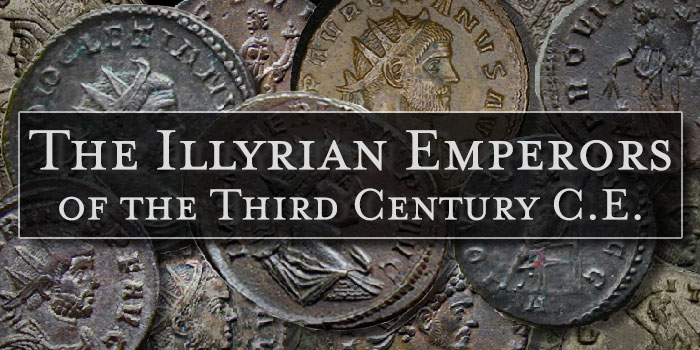
By Steve Benner for CoinWeek …..
By the beginning of the second half of the third century CE, the Roman Empire was in bad shape.
Across the Rhine and Danubian frontiers, there were almost continuous incursions from barbarian tribes like the Alemanni and Goths. These invasions would devastate wide swaths of the Roman Empire.
In the East, the Persian Empire, this time under the Sassanids, was also invading the empire and managing to sack towns like Antioch in Syria. The Sassanids were sophisticated soldiers that could be considered equal to the Roman legions sent against them. The Persians even defeated a Roman army and captured the emperor Valerian.
To exacerbate this situation, whenever a Roman general won a victory, he would rise up against the emperor and try to take the throne, frequently succeeding. There were 10 emperors and many usurpers between the death of Severus Alexander in 235 CE and the ascension of Valerian in 253, with an average reign of one year and nine months per emperor.
With almost constant warfare, the economy was in shambles and inflation was rampant. By the end of Gallienus’ reign in 268, two large sections of the Empire had split off: the Gallo-Roman Empire, centered on Gaul, and the Palmyrene Empire, centered on the city of Palmyra in Syria. Emperor Gallienus (253-68) was partly successful in stabilizing the rump empire, but his generals did not think he was up to the task and killed him in 268.
Claudius II Gothicus
It was with the ascension of Claudius II Gothicus upon the murder of Gallienus in 268 that the period of Illyrian emperors begins. The term “Barracks” or “Soldier” Emperors is often used to emphasize that these rulers rose up through the ranks to reach the purple. “Danubian” is also used since the province of Illyricum was on the Danube River and is a more inclusive term. Illyricum is located in northwestern Greece, north of Macedon and south of the Danube. It included the provinces of Pannonia (upper and lower), Moesia (superior and inferior), and Dalamatia/Illyricum (what are now parts of Austria, Hungary, Slovenia, Croatia, Montenegro, and Albania).

During the reigns of the Illyrian Emperors and up to the reforms of Diocletian, the most common circulating coin was the antoninianus. This silver coin, also called a double denarius, was introduced by the emperor Caracalla in 215. It never quite came up to being double a denarius in weight, and its silver content was almost continuously reduced through the years. By 253 the silver content was down to 40%, 20% by 260, and only 3.5% by 268. The coin had gone from a silver coin to a bronze coin with very little silver and a silver wash that was quickly eroded away.
There were two emperors before Claudius that probably fit into this Illyrian group. The first was Maximinus (235-38), who was born in Thrace or perhaps further north, placing him squarely in the Danubian category, though not Illyrian. Maximinus was an excellent general and rose up from humble origins through the ranks to become governor of Mesopotamia. He killed the emperor Severus Alexander and, as emperor, successfully campaigned against the invading barbarians, especially the Alemanni. Maximinus was killed by his own troops soon after invading Italy.
The second was Trajan Decius (249-51), who was from Pannonia Inferior, a Danubian province in Illyricum. He was another high-ranking general that rose in rebellion and, in this case, killed the emperor Philip. He fought against an invasion of Goths and was killed at the Battle of Abritus.
Figure 2 shows a denarius of Maximinus from 238 and an antoninianus of Trajan Decius from 249-51.
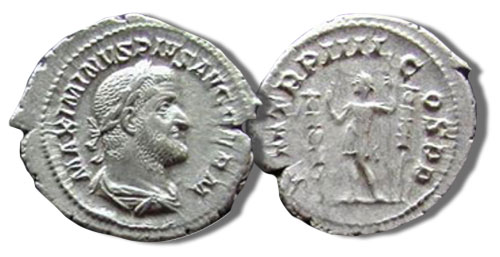
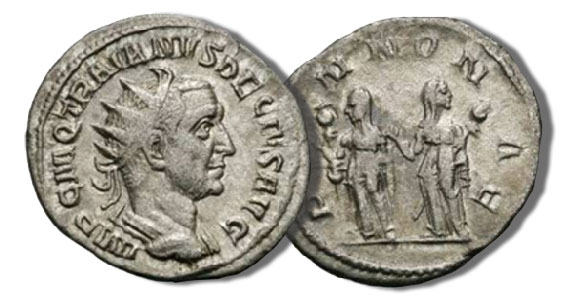
Gallienus had made it so that competent commanders could work their way up through to positions of command, and as a result, a number of his Illyrian commanders (like Claudius) were to become emperors. He also stopped the practice of appointing senators to military commands, which opened up more command positions.
Claudius Gothicus (268-70) was from either Moesia Superior or Pannonia Inferior and rose up through the ranks to become commander of Gallienus’ elite cavalry forces. Claudius was an excellent general and succeeded in heavily defeating the Goths at Naissus and the Alemanni at Lake Bernacus. He was preparing to move against the Vandals when he caught the plague and died. From Claudius until 378, almost all the emperors would be from the Illyrian provinces.
Quintillus
Quintillus was either the brother or the half brother of Claudius and was acclaimed emperor by the Senate upon Claudius’ death.

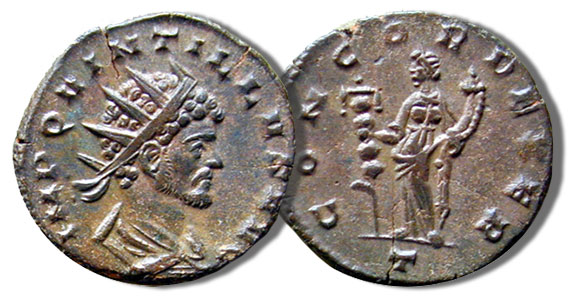
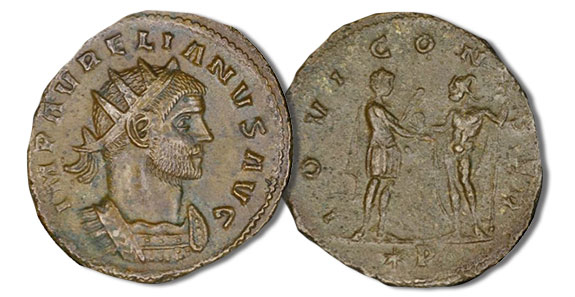
There is considerable confusion as to what happened during his reign since he was emperor for only a few months. The army preferred Aurelian as the new emperor, and Quintillus was either killed by his own men or in battle with Aurelian.
Aurelian
Aurelian (270-75), like Claudius, was born in Illyricum and rose up through the ranks under Gallienus. Once securely in power, Aurelian attacked the Palmyrene Empire in the East and defeated it to bring it back under Roman control. Aurelian did the same thing to the Gallo-Roman Empire, so that by 274 the Empire was complete again – except for Dacia, which had to be abandoned. Aurelian defeated the Marcomanni and the Juthungi and drove them out of the Empire for many years. Because of these invasions, he built a wall around Rome for protection. Aurelian is considered one of the greatest Roman generals and was given the title “Restorer of the World.”
For the first four years of his reign, Aurelian’s coinage was pretty much the same as that of his predecessors. These coins were characterized by portraits that were elderly, stern, and sometimes ugly. The planchets tended to be irregular with rough edges, and the total weight and silver content were very irregular. Aurelian initiated a number of changes: the weight of the antoninianus was increased to about 4.1 grams and the silver content was raised to 5% (1% was probably in the wash). The method of applying the silver wash was greatly improved, the planchets were more rounded and larger, and the lettering and portraiture were improved. This higher-quality coin is sometimes referred to as an aurelianianus.
Later the Emperor began adding XXI (or KA for the East) to the coins, most likely to indicate that the silver content to base metal was now 20 to 1.
In about 274, the mint workers in Rome revolted because the emperor had discovered that they were stealing silver meant for use in the coinage. Aurelian had to violently put down the revolt, with many civilian and military deaths.
Tacitus and Florianus
In 275, as Aurelian was moving to attack the Persian Empire, his generals assassinated him. Another Illyrian general named Tacitus (275-76) was nominated by the Senate to become emperor. Tacitus accepted the purple and, using Aurelian’s army, successfully moved against a number of barbarian invaders. However, he died, probably of fever, only nine months after taking office.
Florianus (276) was Tacitus’ half brother and head of the praetorian guard. He stepped into the role of emperor and received the approval of both the Senate and the Balkan army. He had some success against the Goths, but the Syrian and Egyptian army did not approve of Florianus and elevated their general Probus to the purple.
Less than three months after being hailed emperor, Florianus’ soldiers killed him before they even met Probus in battle.
Probus
Probus (276-82) was an excellent general in the mold of Aurelian. He traveled to all parts of the empire, putting down rebellions and repelling invaders. In Gaul, he defeated the Franks and several Germanic tribes and even attacked across the Rhine into Germania. Probus defeated the Gauls, the Getae, and the Vandals in the Balkans and then moved into Asia Minor to defeat the Isaurians. He was one of the most traveled emperors, having journeyed between Syria and Gaul at least twice.
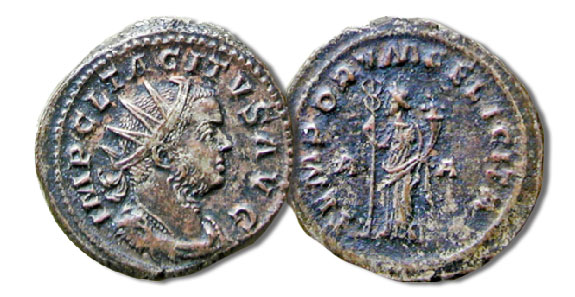

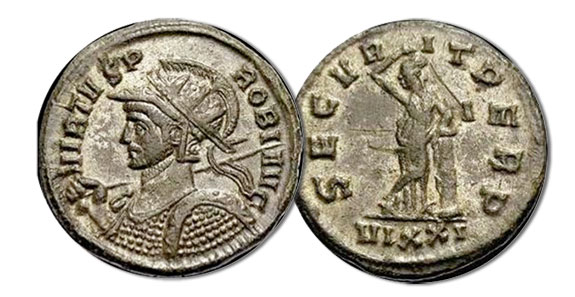
Probus was preparing a campaign against the Persian army when his praetorian prefect, Carus, rose up in revolt against him. Probus’ soldiers, having grown tired of his iron discipline and having to work on civilian projects, killed him near Sirmium in 282.
The coins of Probus have a great variety of obverse types, including elaborate busts and inscriptions. On many types both the obverse and reverse are militaristic. He also created thousands of complex mintmarks and, due to his many travels, there are a large number of Adventus–the welcome an emperor received upon entering a city–types.
Carus, Carinus, and Numerian
Carus (282-83) became Emperor upon the death of Probus and demanded approval from the Senate. He elevated his eldest son, Carinus (283-85), to the rank of Caesar and gave him the West to rule. Soon after, he raised his younger son, Numerian (283-84), to the same rank and took the new caesar with him to the East for an attack upon the Sassanids. Carus repelled an invasion of Quadi and Sarmatians in Pannonia on the way east.
The war against Persia went well, with the Romans capturing the capital, Ctesiphon. But before Carus could move deeper into Persia, he was found dead in his tent, probably having been murdered by his praetorian prefect Aper.
Numerian struck a deal with the Persian king and started the army marching back to the West to join up with his brother Carinus. But on the way, Numerian was found murdered in his litter. The murder was blamed on Aper, who was executed by Diocles (Diocletian). Diocletian (284-304) was then proclaimed emperor by the army.

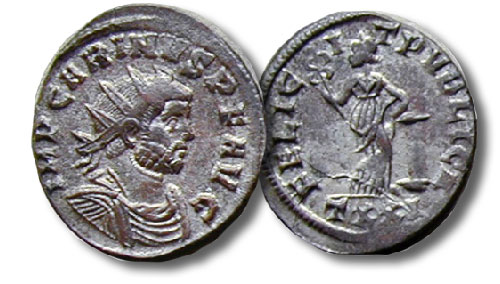

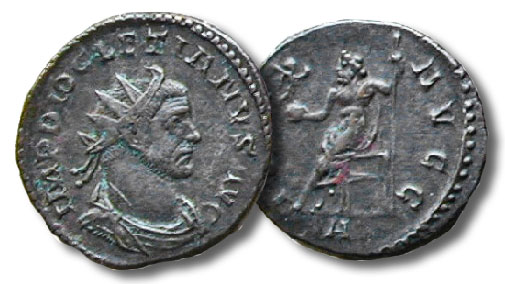
Carinus repelled an invasion of Germans in Gaul and of Quadi along the Danube. After campaigning in Britain, Carinus was moving east to meet with his brother Numerian, who of course died en route and was replaced by Diocletian. The two armies met at Margum, near modern Belgrade. Carinus was killed during the battle by one of his own officers.
Diocletian
The last emperor of the third century was the Illyrian Diocletian, who would rule for 20 years and make many changes to the Roman Empire. He would also reform the coinage, introducing new denominations and eliminating old ones like the antoninianus. His accomplishments were so extensive that they deserve a separate article.
* * *
References
Grant, Michael. The Roman Emperors. Barnes & Noble (1985)
Pearson, Paul N. Maximinus Thrax: From Common Soldier to Emperor of Rome. Skyhorse (2017)
Sear, David. Roman Coins and Their Values II. Spink (2002)
Vagi, David. Coinage and History of the Roman Empire (2 volumes). (1999)
White, John F. Restorer of the World, The Roman Emperor Aurelian. Spellmount (2005)





Absolutely Excellent Research and Article.
Thank You For Your Great Work!
When will you cover the many Constantine family rulers?
I Really Appreciate Your Articles!
An excellent article with great historical facts about the continuous replacement of Roman Emperors in short spans of time. Why would any of the generals want to rise to such powers knowing their fate? I guess rank does have its glories. Well researched article and thanks for educating us.
Most wanted the power and wealth associated with the office, some did it for the empire’s military security, and a few were forced into it by their troops…